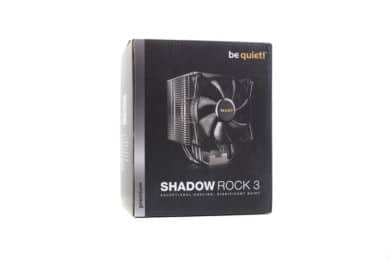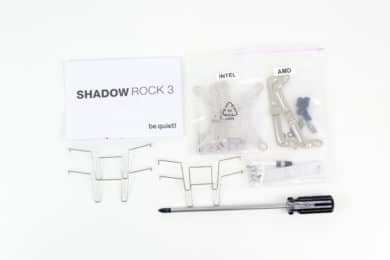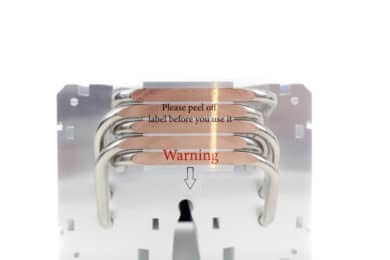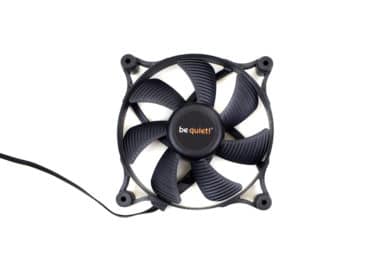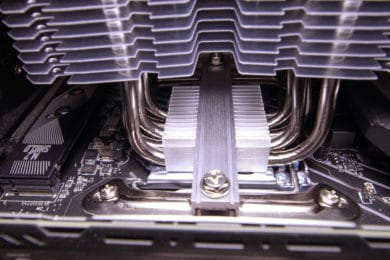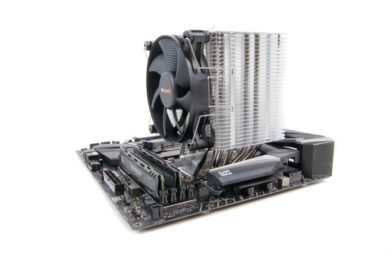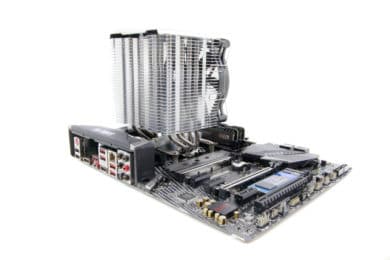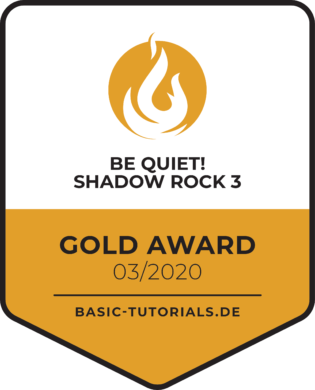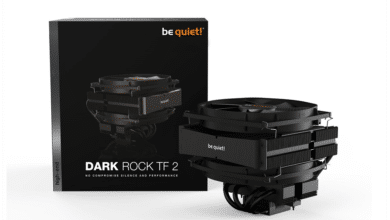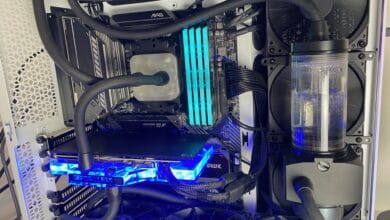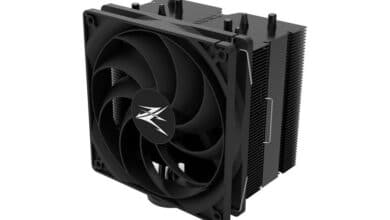
The German cooler brand be quiet! recently unveiled the third generation of the Shadow Rock Tower cooler – we took a closer look at the CPU cooler.
Unlike its predecessors, the Shadow Rock 3 is not symmetrical. The asymmetrical design is said to have improved compatibility with high memory modules. The fan has also been improved, a Shadow Wings 2 in the high-speed version is now included. But there are also some shadow sides which the new version brings along.
For example, the number of cooling fins has been reduced from 51 to 30, and the entire heat sink has also become more compact. The resulting reduced weight should relieve the mainboard – is that really necessary? We doubt it. For us it sounds more like economy measures, just like the modified heatpipes: on Shadow Rock 2 there were four 8mm heatpipes, on Shadow Rock 3 there are five 6mm heatpipes. In addition, be quiet! saves on the copper base plate and now uses direct touch.
All in all, the “improvements” sound rather negative, so we are curious if the be quiet! Shadow Rock 3 can still convince – after all, the TDP has been increased from 180 to 190 watts, so according to be quiet! the new generation should offer better cooling performance than its predecessor. The result of our be quiet! shadow rock 3 test can be found in this review. We didn’t make a comparison with the Shadow Rock 2, but with the be quiet! silent loop water cooling system with 240 mm radiator.
Technical details
| General data | |
|---|---|
| Model | Shadow Rock 3 |
| Overall dimensions without mounting material (L x W x H), (mm) | 121 x 130 x 163 |
| Total weight (kg) | 0.71 |
| TDP (W) | 190 |
| Socket compatibility | Intel: 1200 / 2066 / 1150 / 1151 / 1155 / 2011(-3) Square ILM, AMD: AM4 / AM3(+) |
| Fan model, amount | 1x Shadow Wings 2 120mm PWM high-speed |
| Decoupled fan mounting | ✓ |
| Overall volume @ 50/75/100% (rpm) | 11.5 / 17.5 / 24.4 db(A) |
| Price | € 51.19 |
| Cooler specifications | |
| Dimensions (L x W x H), (mm) | 96 x 130 x 163 |
| Number of cooling fins | 30 |
| Fin material | Aluminum |
| Base material | aluminum / copper |
| CPU contact area | Heatpipe-Direct-Touch |
| Heatpipe Number, diameter (mm) | 5 / 6 |
| Surface treatment | Aluminum |
| Fan specifications | |
| Fan dimensions (mm) | 120 x 120 x 25 |
| Speed @ 100% PWM /12V (rpm) | 1,600 |
| Bearing technology | Rifle |
| Engine technology | 4-pole fan motor |
| Rated voltage (V) | 12 |
| Rated current (A) | 0.20 |
| Power consumption (W) | 2.4 |
| connecting plug | 4-pin PWM |
| Cable length (mm) | 220 |
| Life expectancy @ 25 °C (hours) | 80,000 |
Packaging & scope of delivery
The Shadow Rock 3 is delivered in a black cardboard box, which is printed with numerous information. Unfortunately only in English, but don’t worry: The assembly instructions are in English and German.
Besides the heat sink, the mounting material (backplate, screws, spacers, brackets) for all common Intel and AMD sockets is included. Only the Threadripper platform is not supported. Also included is a fan as well as mounting brackets for two fans – so you can mount another fan later. Thermal paste and a screwdriver with a magnetic tip complete the package.
Design & Workmanship
be quiet! has significantly reduced the weight of the cooler due to the reduced number of fins. At 710 grams, the CPU cooler is a true lightweight among tower coolers. The distance between the 30 aluminium fins is comparatively large, more air can flow through.
Five heatpipes with a diameter of six millimetres conduct the heat from the processor to the cooling fins. Here too, be quiet! has made some savings, now using direct touch technology. So there is no longer a copper base plate, but the heat pipes are connected and ground off and lie directly on the processor.
Although be quiet! paid attention to high compatibility during the development of the Shadow Rock 3, there are limitations. The asymmetrical design allows the use of high memory modules without the cooler interfering. However, be quiet! did not consider the height, because with 163 millimeters, many cases fall just off the compatibility list, as they only allow a height of 160 millimeters. Cheapskates can find 946 cases with up to 160 millimeters, but only 356 with more space.
The cooler used is a Shadow Wings 2 with PWM control, 120 millimetres in diameter and up to 1600 revolutions per minute. It is decoupled from the heat sink with rubber buffers and mounted with simple metal retaining brackets.
The workmanship of the cooler and the fan is excellent. There are no bent fins or sharp edges. Also the anodization of the heat sink cover is perfect.
Mounting
We mounted the processor cooler on a quite powerful system. The test system consists of the following components:
- MSI Z370 Gaming Pro Carbon Mainboard*
- Intel Core i7-8700K processor*
- 32 GB Crucial DDR4-3000 RAM*
- ASUS GeForce GTX 1080 Ti Strix graphics card*
Everything was installed in a housing with open side wall so that there is no heat accumulation and the cooling capacity can prove its ability.
The assembly was super easy. After removing the old CPU cooler, we first attached the backplate of be quiet! To do this, simply push screws through the backplate, fix them with rubber rings and then push them through the mainboard. There it is then fixed with thumbscrews. Afterwards the retaining brackets were screwed together with the included screwdriver. Now you can apply the heat-conducting paste to screw the be quiet! shadow skirt 3 to the mounting brackets. Please note that one of the screws is below the heat sink, so the long screwdriver supplied must be inserted through the heat sink to tighten the screw.
Last but not least, only the fan needs to be attached. This is decoupled with rubber buffers in order not to transfer the vibrations to the large heat sink and thus cause noise. It is simply attached with two metal clips. be quiet! also comes with four metal clamps, so that an additional fan can be mounted as an option.
The mounting is well thought-out, quickly done and then holds bombproof. There were no problems during installation due to the asymmetrical construction, there is more than enough space for the RAM, so that it can be unlimited high. Also with plug-in cards like the graphics card there are no problems.
Volume and cooling capacity
Our built-in Intel i7-8700K is beheaded, but not overclocked. It is therefore a bit cooler than a conventional i7-8700K. To test the cooling performance, we loaded the processor with Prime95 for 15 minutes and read the temperature with CPUID Hardware Monitor.
We decided not to let the fans run at 100% speed, as this is unrealistic. Instead, we kept the fan curve of our mainboard.
| Cooler | Operating scenario | RPM | Temperature |
|---|---|---|---|
| be quiet! Silent Loop 240 mm | auto | 1000 rpm | 78 °C |
| be quiet! Shadow Rock 3 | auto | 700 rpm | 69 °C |
From the fan speed you can already see that the Shadow Rock 3 dissipates heat much better than the Silent Loop 240 mm water cooling. It is cooler and therefore needs to be turned up less. With 700 revolutions, it doesn’t even work at 50% of the possible speed (1600 rpm) despite 100% CPU usage. So it is pleasantly quiet and still cools efficiently. Better and quieter than water cooling.
Conclusion of the be quiet! Shadow Rock 3 review
With the Shadow Rock 3 be quiet! has once again released an exciting new CPU cooler. Despite material savings, it delivers solid performance and even cools better than an in-house water cooler. The cooling performance can even be further improved with a second fan, which can be optionally retrofitted.
The mounting system has been well thought out and the workmanship has been successful. Visually, be quiet! is very discreet as always. The heat sink is only anodized black on the upper side and RGB lighting is also missing. If you prefer simple elegance, you’ve come to the right place.
Nevertheless, we’ll have to see how the price develops in the next weeks and months. With a RRP of 49.90 Euros, the be quiet! Shadow Rock 3 is still comparatively expensive. As soon as the price has dropped by 5 to 10 Euros, the CPU cooler will become even more interesting.
be quiet! Shadow Rock 3
Design
Workmanship
Mounting
Cooling
Volume
Value for money
94/100
Simple air cooler with good cooling performance!


